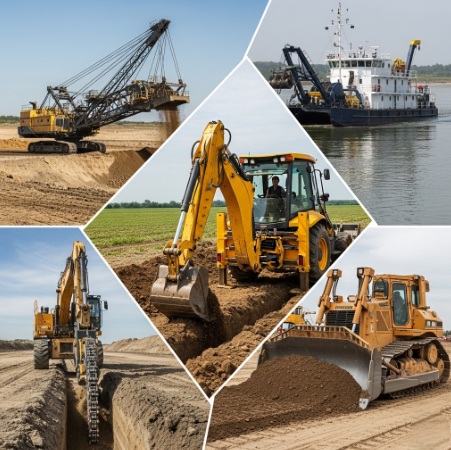
Civil engineers rely on powerful machinery to prepare sites and shape the landscape for various projects. These machines are the true workhorses of the industry, and they all have specific roles. You need to understand the different types of key excavating plants to choose the right one for a job. This guide explores the most common types and their unique applications in civil engineering.
Excavators (Backhoes/Backacters)
Excavators are arguably the most versatile machines on a construction site. They are incredibly useful for a wide range of tasks, from digging trenches for foundations and pipelines to demolition work. These machines feature a cab that can rotate a full 360 degrees, providing the operator with excellent visibility and flexibility. You can also attach various tools to the end of the boom, such as hydraulic breakers, grapples, and augers, which increases their utility.
We differentiate excavators based on their mobility. Wheeled excavators are perfect for urban environments and paved surfaces because they are easy to move between jobs without causing damage. In contrast, tracked or crawler excavators are the champions of rough, uneven terrain. Their tracks distribute the machine’s weight, giving them exceptional stability and traction on soft or sloped ground.
Draglines
When a project calls for massive bulk excavation, a dragline is the machine for the job. These colossal machines are not mobile in the same way as an excavator. Instead, workers often assemble them directly on-site due to their sheer size. A dragline uses a long boom and a heavy drag bucket to scoop up large volumes of material. This makes them ideal for large-scale operations like dredging canals and rivers, strip mining, and other major earthmoving projects where immense quantities of material must be removed. The long reach of their boom allows them to work from a safe distance, moving earth efficiently.
Dredgers
Dredgers are specialized machines designed specifically for underwater work. They are essential for maintaining and developing waterways. You will find them working to deepen rivers and harbors to allow for larger ships to pass safely. They are also crucial for land reclamation projects, where they pump sand and sediment from the seabed to create new land. Dredgers come in many forms, from mechanical excavators mounted on barges to suction dredgers that use powerful pumps to move underwater material. These machines play a vital role in coastal engineering and port infrastructure development.
Trenchers
For the specific task of digging narrow, deep trenches, a trencher is the most efficient tool. Civil engineers use these machines extensively for installing utilities like water pipes, gas lines, and electrical cables. There are two primary types of trenchers. Chain trenchers use a long chain with sharp teeth to cut a precise trench in the ground. Wheel trenchers, on the other hand, use a large metal wheel with teeth around its circumference. Both types are designed for precision and speed, ensuring a clean and consistent trench for easy installation of services. The use of a trencher is the best way to ensure a uniform trench.
Bulldozers
While a bulldozer is not a primary digging machine, it is an absolutely essential part of site preparation. Bulldozers use a large, heavy blade at the front to push and move large quantities of earth, rocks, and debris. They are indispensable for clearing a site of vegetation and rubble, leveling uneven ground, and spreading materials like gravel and soil. They are also used to create temporary access roads on large construction sites. In combination with the other key excavating plants, a bulldozer helps to create a clean, level, and stable foundation for any civil engineering project. For more detailed information, you can read this article on heavy equipment from a different perspective at the Federal Highway Administration website.
References
- Peck, R. B., Hanson, W. E., & Thornburn, T. H. (1974). Foundation Engineering. John Wiley & Sons.
- U.S. Army Corps of Engineers. (2001). Dredging and Dredged Material Management. EM 1110-2-5025.
- Murdock, L. J., & Hughes, G. M. (1984). Civil Engineering Drawing and Design. Butterworths.
Leave a Reply